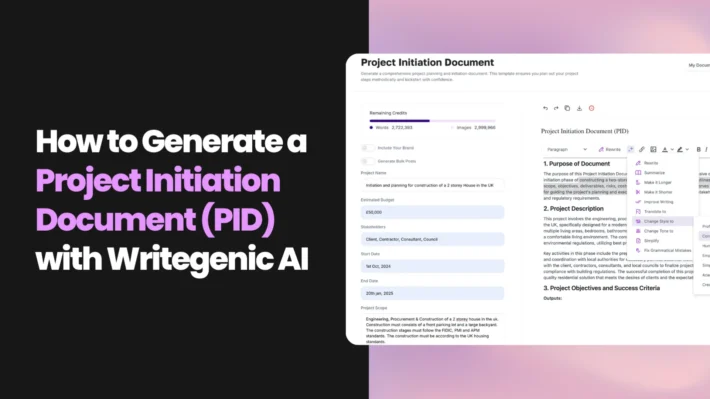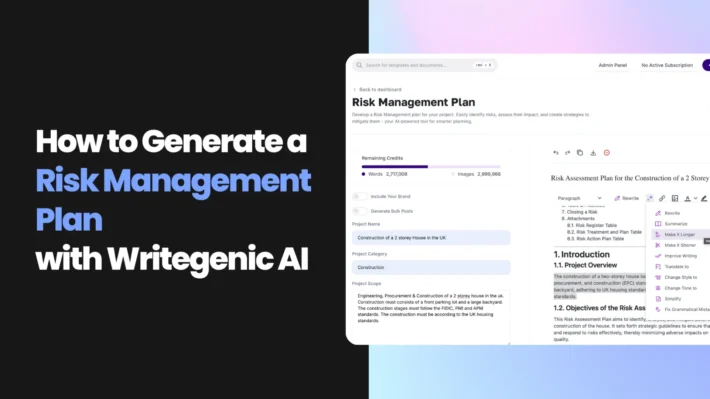How to Create a Standout LinkedIn Profile Using AI
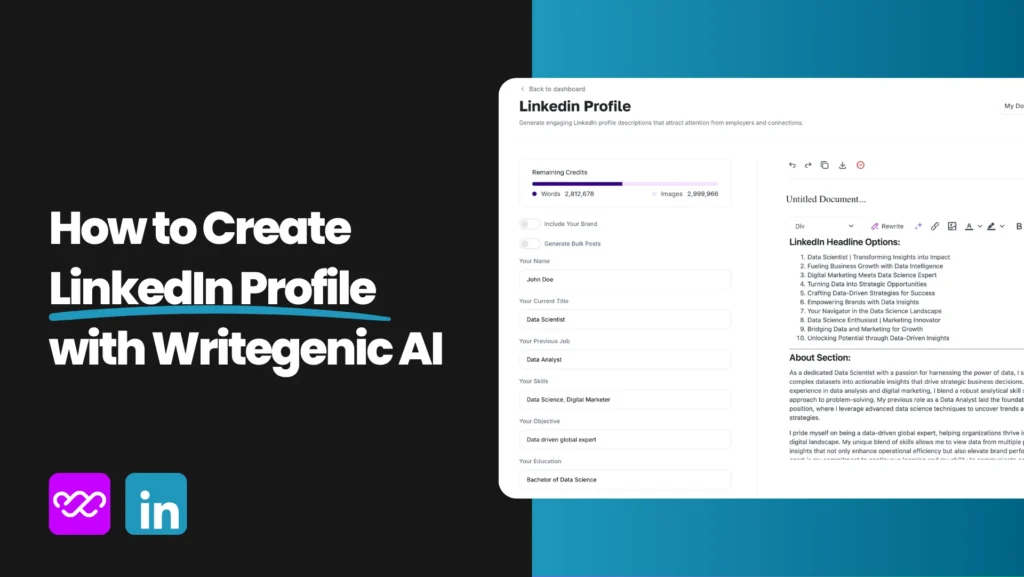
In today’s digital space, our LinkedIn profile serves as our professional business card. Be it for job seeking, personal branding, or client search, LinkedIn is the most crucial platform that gets us connected with millions of professionals.
As one of the most important tools for credibility, authenticity, and authority in our industry, LinkedIn boasts over 1 billion active users across the world. Before anyone accepts our connection, request, or considers our services, they are likely to check our LinkedIn profile first.
An effective LinkedIn profile is just what we need to stick out in a crowded marketplace and leave that lasting impression on the person who matters. In this detailed article, we will walk us through the full journey of creating a stellar LinkedIn profile using the “LinkedIn Profile” template provided by WriteGenic AI from headline optimization to recommendations.
Why LinkedIn Profile Optimization Matters
Before we get to the template, here’s why LinkedIn profile optimization is critical:
- Credibility: A well-crafted LinkedIn profile showcases our professional capabilities and positions us as a credible authority in our field.
- Authenticity: LinkedIn is a platform for real networking. An optimized LinkedIn profile makes us an authentic and trustworthy professional.
- Authority: When potential employers or clients look at our LinkedIn profile, they assess our authority in the industry. One’s LinkedIn account must be optimized so that one can make quite an impression.
For job seekers, client seekers, HR recruiters, and anyone aiming to grow their personal brand, the first impression often comes from our LinkedIn profile. That’s why it’s vital to ensure that our LinkedIn profile speaks to our audience effectively.
How to use Writegenic AI’s LinkedIn Profile Maker step-by-step
Step-1: Open LinkedIn Profile Template:
(Option 1) To quickly find the “LinkedIn Profile” template, simply enter the name in the search bar located at the top of the WriteGenic AI’s dashboard.
(Option 2) Go to AI Writer: Alternatively, navigate to the left navigation pane, click on “AI Writer,” and select the “Social Media” group of templates. Navigate to the ‘LinkedIn Profile’ template and click on it to begin working with this template.
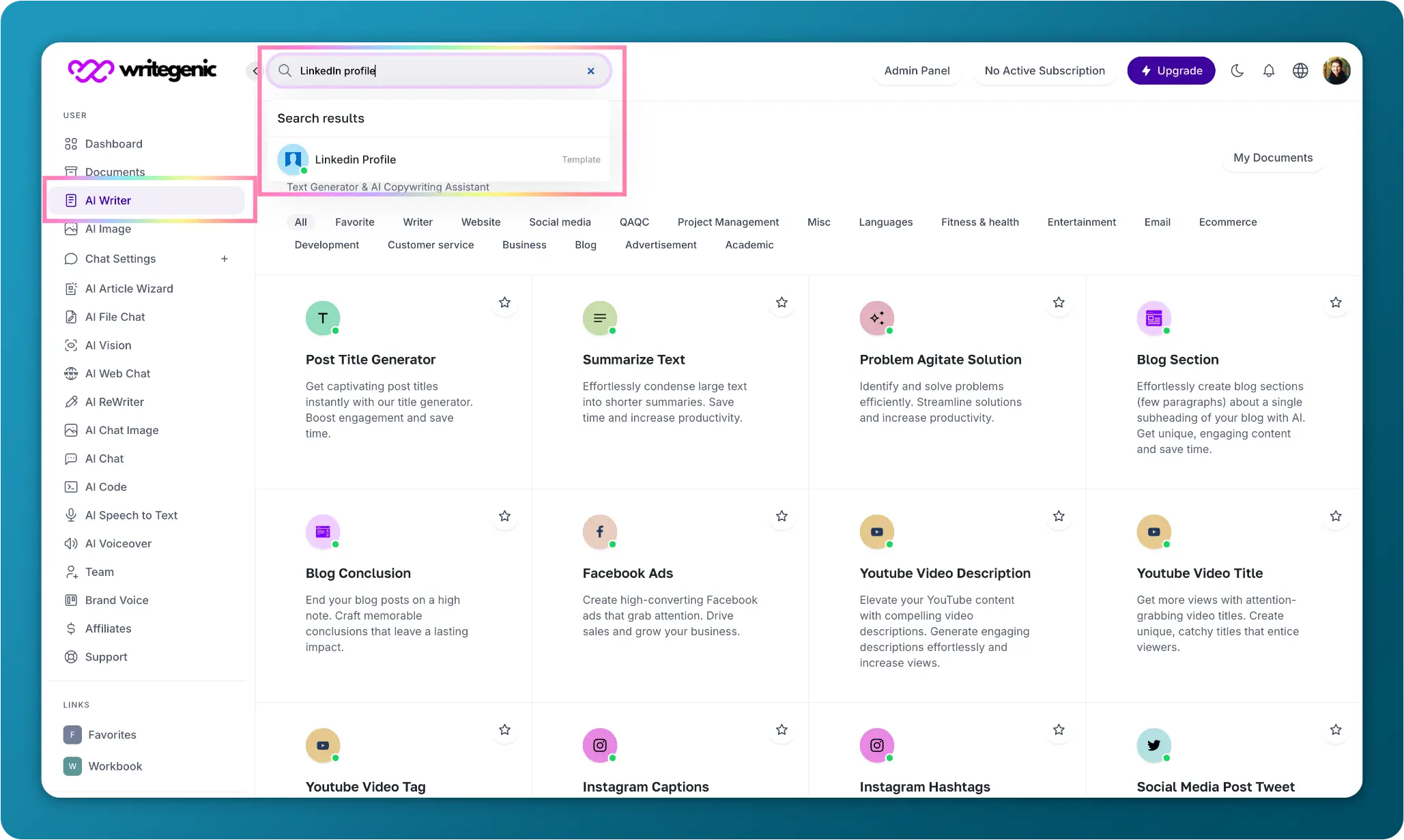
Step 2: Enter Essential Information
Once the LinkedIn Profile template is open, we will be prompted to fill in the key information about ourselves. Now we should get to know about the key inputs in depth as below:
- Your Name:
This is the easiest part; Just type in your full name as you want it to appear on your LinkedIn profile.
Tip: Using our real name (no nicknames or abbreviations) is a sign of professionalism and we will earn others’ trust.
Example: David Webb
- Your Current Title:
This is where we will insert our current designation and company name.
Why does your current title matter? This title is one of the first things somebody is going to see when looking at our LinkedIn profile, and it should be up-to-date, and accurate to our current position so that people know right away what we do.
How to Optimize: If we are an active job seeker, include keywords from our target job role to improve discoverability.
Example: Senior Data Engineer at XYZ Tech Solutions
- Your Previous Job
Enter our previous job title, along with the company name where we were employed. This offers important background information regarding our work experience.
Why does your previous job matter? Listing our previous roles builds credibility and shows our career progression.
How to Optimize: Separated by commas to mention notable achievements in this role.
Example: Data Analyst at ABC Technologies, Data Engineer at XYZ company
- Your Skills
List our key skills here, separated by commas. This is an important section because it brings out the areas where we excel. These skills also lend to making our LinkedIn profile more searchable by either a recruiter or a client.
Why does your skills matter? A strong skills section provides a quick overview of what we can do, that might distinguish us from other employees or clients.
How to Optimize: Use a mix of hard skills (technical abilities) and soft skills (teamwork, communication).
Example: Data Analysis, SQL, Project Management, Leadership, Business Intelligence
- Your Objective
This is where we state our main career objective or target audience. It reflects our current goals or the type of connections and opportunities we are seeking on LinkedIn.
Why does your objective matter? A clear objective makes our LinkedIn profile more focused and helps attract the right opportunities.
How to Optimize: Use this section to demonstrate what we are looking for and why we are an ideal fit for potential employers or collaborators.
Example: Seeking senior-level roles in Data Engineering where I can leverage my experience to drive innovation and efficiency.
- Your Education
Here, we should input our highest qualification degree. This includes the degree name and the institution where we completed it.
Why does mentioning our education matter? Education is an essential part of our professional background, giving credibility to our qualifications.
How to Optimize: Mention any certifications or additional qualifications relevant to our field as well.
Example: Master’s Degree in Computer Science from the University of XYZ
- Your Summary
This is the heart of our LinkedIn profile, where we describe ourselves briefly. This section shows the professional background of a candidate, key achievements, and what makes him or her unique. We should also discuss the value we provide in our professional roles.
Why does a summary about ourselves matter? A well-written summary in our LinkedIn profile grabs the reader’s attention, making them want to learn more about us. It should highlight our expertise, abilities, and professional aspirations.
How to Optimize: Write in the first person and make it conversational but professional. Avoid jargon and emphasis on strengths. Highlight some of our key professional interests, what motivates us, and what we are aiming to achieve in our careers.
Example: “I am a dedicated Data Engineer with more than seven years of experience in creating scalable data solutions and effectively guiding teams to achieve their goals. I specialize in data analysis, cloud computing, and business intelligence, helping businesses drive data-informed decisions using my expertise. Holding a master’s in computer science, I have been able to extend such value to high-profile projects, which have optimized processes and increased productivity for clients. Nowadays, I seek leadership that will enable me to continue leading and mentoring upcoming data professionals with my innovative skills”.
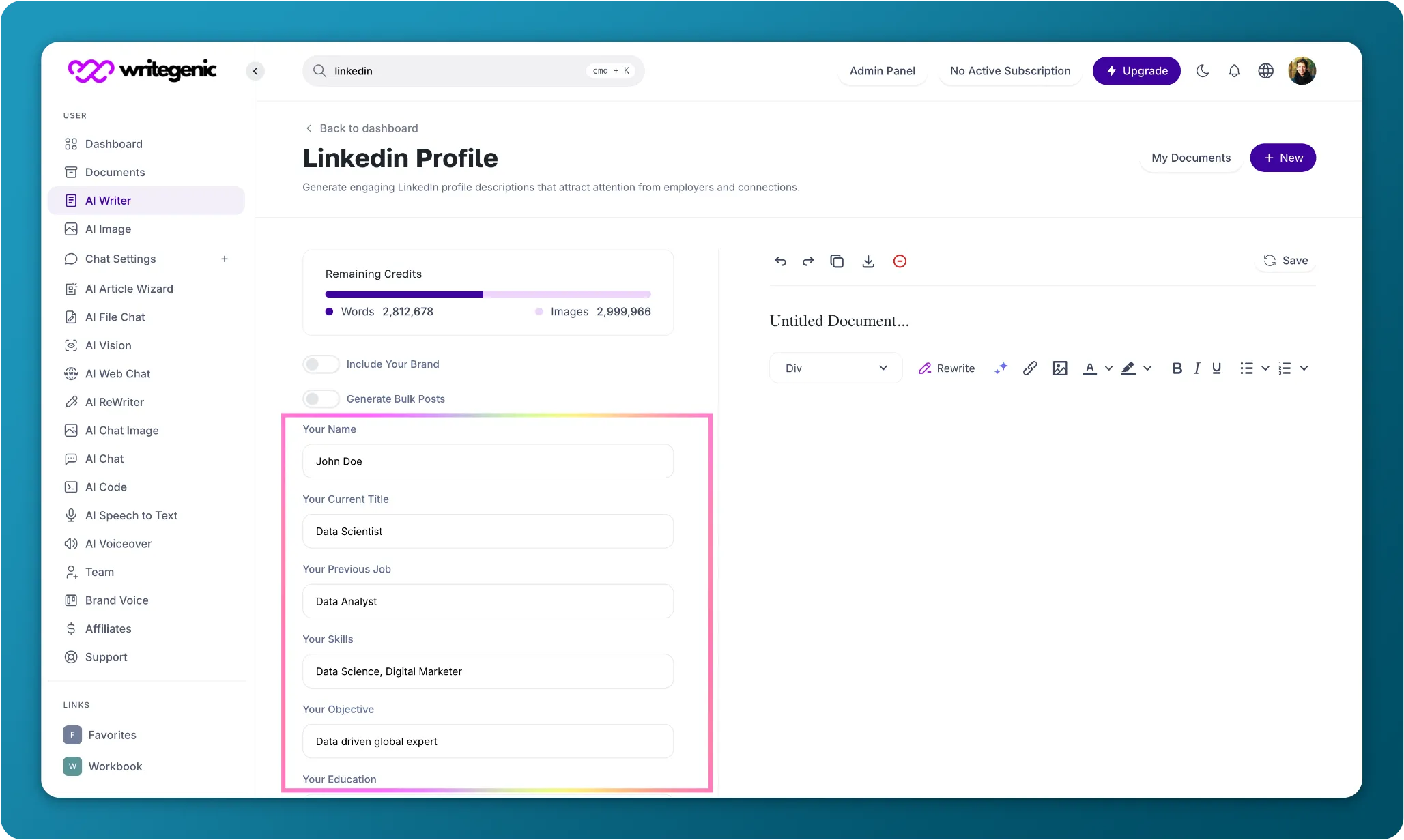
Step 3: Generate the LinkedIn Profile content
Once we have entered all the necessary information, proceed by clicking the Generate button. This will initiate the process of generating our LinkedIn Profile. To enhance visual appeal, consider using the AI Image Generator to create professional profile images or banner graphics. Now copy-paste the generated content from the LinkedIn Profile template to the LinkedIn account.
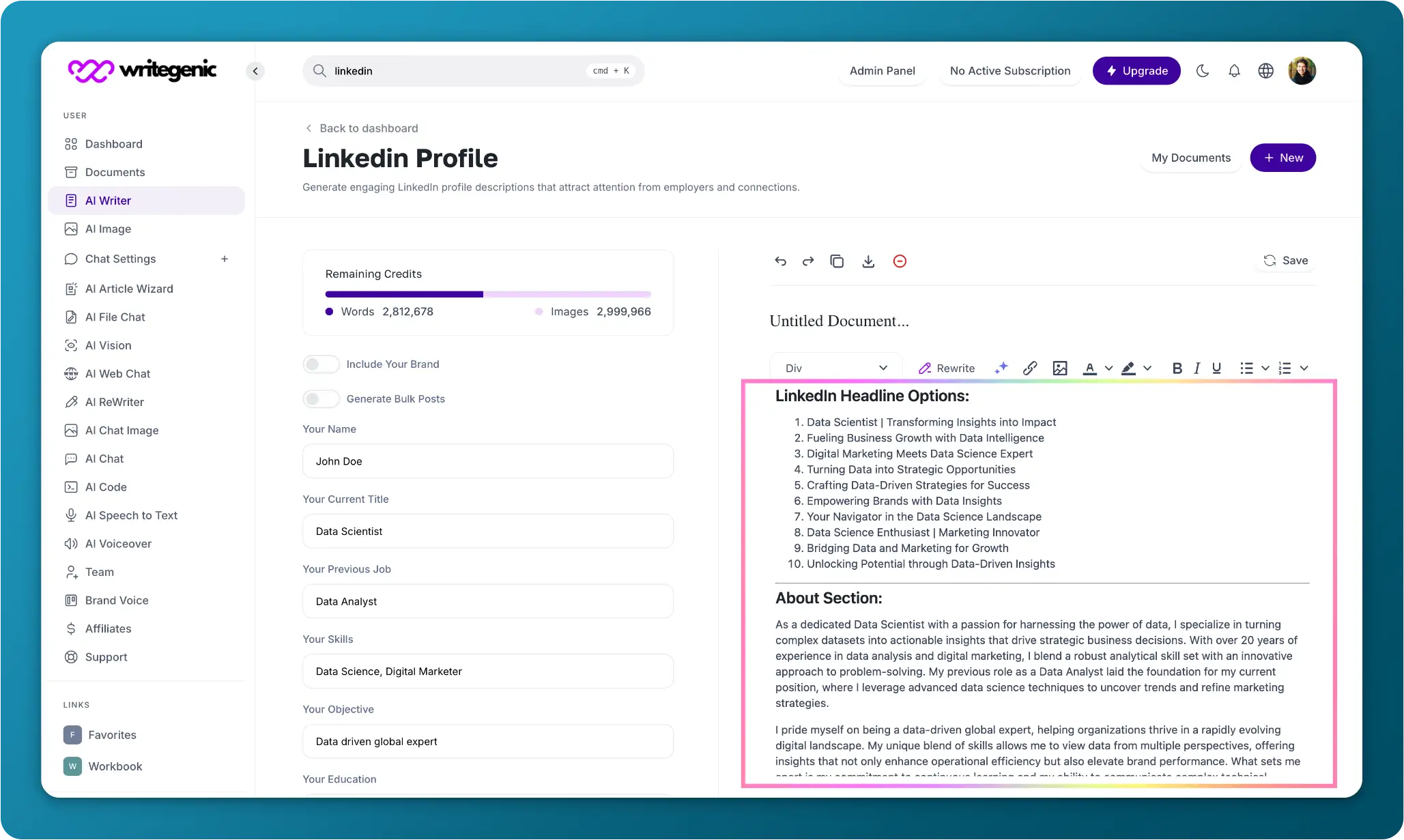
Benefits of Using WriteGenic AI’s LinkedIn Profile Template
Here’s a comprehensive template for crafting a standout LinkedIn profile, covering each section in detail:
- Headline
The headline is an essential element of our LinkedIn profile, as LinkedIn automatically populates it with our current job title. This text appears directly below our name and plays a key role in how we present ourselves professionally. However, a well-thought-out headline can be much more than this: it can portray our value proposition and expose us to the search results.
The formula for a Winning Headline:
- Use keywords relevant to our industry.
- Mention our unique selling proposition (USP).
- Highlight how we help others or solve problems.
- Max Headline length should be less than 220 characters long.
Examples of optimized headlines:
- “Helping businesses expand through data-driven digital strategies | Certified SEO Expert”
- “AI and Machine Learning Specialist | Supporting Startups in Their Innovative Efforts”
- “Driving Sales with Tailored Digital Solutions | B2B SaaS Specialist”
- About Section
The About section is where we get to tell our story in our own words. Use this section to provide a clear but concise overview of:
- who I am,
- what I do, and
- why do I do it
Key Elements to Include:
- Introduction: Start with a brief introduction that summarizes our current role and career background.
- Value Proposition: What differentiates us? Bring in the key strengths that we bring to the table.
- Career Highlights: Mention any big accomplishments that we may have achieved via specific projects, numbers involved such as KPIs, or accolades.
- CTA (Call to Action): Make it actionable for the reader. This can be something as simple as connecting with us, visiting our website, or even contacting us for services.
WriteGenic AI’s Suggested example for the About Section: “Enabling innovations in data analytics and cloud technologies, I am specialized in providing cutting-edge solutions. During the last decade, I have been a part of the global team, working towards establishing scalable architectures of big data, and moving finance and healthcare companies forward by giving them a way to increase their operating efficiency by up to 20%. Excited to connect and explore ways I can bring value to our organization!”
- Experience
Our experience section should not be just the listing of the designations held but needs to speak of our progression and achievements for every posting.
How to Structure:
- Job Title: Our designation must be appropriate and to the point. We can also use keywords in our designation for better visibility.
- Description: Incorporate bullet points to outline our responsibilities, while focusing on highlighting our accomplishments instead.
- Metrics: What metrics do we use to define our work and prove the value of that work? For example, revenue generated, cost savings, and projects completed well in advance of the deadline.
Example of an experienced Entry Senior Data Engineer, XYZ Tech Solutions, 2020 – Present
- Spearheaded cloud-based data warehouse development to reduce retrieval time by 30%.
- Managed a team of five engineers to design and implement machine learning models, resulting in a 15% boost in predictive accuracy.
- Collaborated on cross-functional teams to allow for seamless ingestion of the data pipeline, reducing company costs by 10%.
- Education
Education will give us a section to project our academic background, like any relevant degree and certification, course work-especially if those tie in with the roles or services we are offering.
Best Practices:
- Include details like GPA (if it’s impressive), honors, or relevant coursework.
- Add any certifications that bolster our credibility.
- Skills and Endorsements
The Skills section is where we show our strengths in certain key areas. We can add up to 50 skills in our LinkedIn account, but it’s better to include the most relevant items that pertain to our industry.
Best Practices:
- Ensure our top three skills align with our personal brand and headline.
- Regularly update our skills to reflect new areas of expertise.
- Recommendations
Endorsements act as valuable social proof, highlighting our skills and dedication. Seek to get at least 3-5 strong recommendations from colleagues, clients, or supervisors.
Best Practices:
- Ask that recommendations be written by individuals who can address our diverse skills and experience.
- Offer recommendations to others, as this might motivate them to return the favor.
Example of a Strong Recommendation: “Mr. XYZ was an outstanding leader during our tenure at ABC Corporation. His data-driven approach toward problem-solving helped our team nail its KPIs every time. His acumen in cloud technologies and data analytics was instrumental in building scalable systems that improved our bottom line. I strongly recommend Imran for any leadership role in data engineering.”
- Accomplishments
Enumerate any honors, awards, publications, certifications, and even volunteer activities. This is a superb method of differentiating one’s self based on professional and personal achievement.
Best Practices:
- Add any notable accomplishments that are relevant to our field.
- Include publications if we have contributed to industry research or written authoritative articles.
Why a LinkedIn Profile is Important for any Professional
- Establishes Credibility and Authority: A well-placed LinkedIn profile helps in establishing credibility for a person in their respective field. This speaks to one’s qualifications, expertise, and achievements through a formal and verifiable environment. The feature of endorsements and recommendations allows others to vouch for our skills and further build our authority.
- Increases Professional Visibility: It can promote our professional visibility. By incorporating relevant keywords into our headline and summary, our LinkedIn account is more likely to appear in search results. This enhances our chances of being noticed by recruiters, clients, or collaborators who are actively seeking talent with skills and expertise like ours.
- Fosters Networking Opportunities: LinkedIn helps us to grow our professional network, starting with our locale and expanding to a global reach. Whether it is peer collaboration, building thought leadership, or finding job opportunities, LinkedIn connects us with just the right people to leverage.
- Amplifies Personal Branding: Our LinkedIn profile serves as a digital resume and portfolio, offering an opportunity to showcase and strengthen our personal brand. We display consistent insights, achievements, and updates that create differentiation with a solid reputation in our industry.
- Job Searching and Career Development: Many recruiters hire only from LinkedIn. It gives professionals the avenue to be viewed based on their skill set and experience for potential employment. Even the passive job seeker benefits from having a regularly updated LinkedIn account, as it opens up opportunities that may not have been sought.
Importance of LinkedIn for Different Stakeholders
- Digital Marketers
For digital marketers, LinkedIn Profile provides a platform to:
- Demonstrate Expertise: It allows marketers to showcase experience in running successful campaigns, strategies related to marketing, and analytics, among other aspects, which provides potential clients or employers with extensive information about what they are capable of doing.
- Network with Clients: An optimized LinkedIn account, using the right keywords, will attract potential clients seeking marketing services.
- Brand Authority: Digital marketers build thought leadership and establish authority in their niche through consistent sharing of marketing insights, case studies, and industry news.
- Business Developers
For business developers, LinkedIn Profile is essential for:
- Lead Generation: LinkedIn is a source for connecting with decision-makers, potential partners, and clients. It lets them identify and connect with the right leads in their target market.
- Showcasing Results: A business developer showcases, through their LinkedIn profile, how many partnerships they were able to forge or deals they were able to close in the past. This will act as a testament to their ability to grow a company.
- Building Relationships: By leveraging LinkedIn’s messaging and connection features, business developers can nurture relationships that lead to future collaborations or business opportunities.
- Project Managers
For project managers, LinkedIn Profile plays a vital role in the following ways:
- Highlighting Experience: On LinkedIn, project managers can showcase their projects, which have been managed successfully with any information associated with it, such as budget and timeline, taken to its conclusion.
- Skills Endorsements: Through the endorsement of key skills necessary for project managers in leading teams, management, and problem-solving, project managers can affirm their competencies in the field.
- Networking: It provides a platform for project managers to connect with professionals across various industries. This opens up opportunities for them either to lead new projects or work with key stakeholders.
- Recruiters (Talent Seekers)
For recruiters or talent acquisition professionals, LinkedIn Profile serves as an essential platform that streamlines the process of identifying and engaging top candidates:
- Accessing a Global Talent Pool: With LinkedIn, recruiters can source qualified candidates with particular skills, education, or experience. They can filter these results by a variety of factors down to the most ideal candidate to fill a particular job position.
- Building Employer Branding: This helps the recruiters show their organizational culture and values and thereby state the openings in front of the best talents through company pages or even their LinkedIn accounts.
- Connecting with Passive Candidates: LinkedIn enables recruiters to connect with individuals who aren’t actively job hunting but may be open to exploring new opportunities.
Types of LinkedIn Users and Their Objectives
- Job Seekers
Job seekers comprise one of the biggest categories on LinkedIn. Whether they are active in their job search or merely passive in seeking other opportunities, LinkedIn Profile would offer the following to job seekers:
- Access to Job Postings: LinkedIn boasts several job postings running into millions from a wide variety of career fields. On this site, job seekers can apply directly and set up job alerts.
- Networking with Recruiters: Job seekers may reach out to recruiters, HR professionals, and industry experts who can lead them to jobs.
- Personal Branding: It helps job seekers to do some personal branding through LinkedIn accounts showcasing working experience, skills, and achievements, and attracting potential employers.
- Skill Development: Job seekers have courses and certifications from LinkedIn Learning to upgrade their skills and increase employability.
- Client Seekers (Freelancers/Consultants)
Client or Customer seekers use LinkedIn to find freelance work, consulting gigs, or contract-based projects. Their primary goals include:
- Attracting Clients: Through an optimally LinkedIn profile highlighting of their services and experience, clients can look towards them in search of services and skill sets.
- Building Relationships: Joining LinkedIn groups, commenting on posts, or sending customized invitations are some of the ways by which client seekers can connect with prospective customers.
- Showcasing Work: Freelancers and consultants use LinkedIn to highlight their work portfolio, case studies, and testimonials that build trust in potential customers.
- Talent Seekers (Recruiters/HR Professionals)
Talent seekers are professionals focused on finding the right candidates for job openings. They use LinkedIn to:
- Search for Qualified Candidates: Recruiters make use of advanced search features to identify prospective candidates based on location, skills, experience, and education.
- Engage with Passive Candidates: Even though a person is not in search of employment, through conversations, a recruiter can easily reach passive candidates and build relationships for future opportunities.
- Promote Company Culture: Talent seekers make use of LinkedIn to showcase their company brands through the promotion of vacancies and sharing of achievement updates about the companies.
- Business Developers
LinkedIn is used by business developers to extend the reach of their company by finding and reaching out to potential partners, investors, and clients. Their focus is on:
- Generating Leads: This enables business developers to connect with decision-makers and stakeholders in their target industries.
- Building Relationships: They could engage with prospects through customized connection requests, messages, and sharing of content for nurturing a long-term business relationship.
- Showcasing the Company’s Value Proposition: Business developers showcase an appealing LinkedIn account highlighting the strengths of the company, including its unique value. This may help them in capturing the attention of potential clients and partners.
- Thought Leaders and Influencers
Thought leaders use LinkedIn to establish themselves as experts in their industry. Their objectives include:
- Sharing Knowledge: Share articles, posts, and comments on topics related to the industry, done to engage followers and earn credibility.
- Building a Following: While leaders grow their circles of influence with regular streams of credible and relevant content to which target audiences connect.
- Monetizing Influence: A large number of thought leaders use the eventual visibility on LinkedIn to get speaking gigs, consulting opportunities, and other monetized collaborations.
LinkedIn as an All-In-One Platform
Whether we are a job seeker, business developers, digital marketers, project managers, or talent seekers, LinkedIn is about professional success. It allows us to:
- Build and showcase our personal brand
- Establish credibility and authority
- Connect with industry professionals
- Create new career or business opportunities
From optimized LinkedIn profiles to networking and beyond, even to sharing updates, leveraging each of LinkedIn’s many features will serve to further our professional presence and unlock a world of possibilities. In fact, for freelancers and owners of large-scale businesses alike, having an active and optimized LinkedIn account is no longer optional but a necessity for thriving in today’s digitally connected professional world. Additionally, utilizing AI for Project Management can help professionals streamline tasks, enhance collaboration, and improve efficiency in managing projects directly from LinkedIn connections.
FAQs about LinkedIn Profile Template by WriteGenic AI
Writing a noticeable LinkedIn profile is the need of the hour in today’s professional world. Here are some frequently asked questions, which give answers to commonly asked questions and help to attain perfection in our LinkedIn profile with the help of the WriteGenic AI “LinkedIn Profile” template.
1. How does the WriteGenic AI LinkedIn Profile template help me?
WriteGenic AI’s u0022LinkedIn Profileu0022 template provides:u003cbru003eu003cstrongu003eStep-by-step guidanceu003c/strongu003e: It walks us through each section of our LinkedIn profile, from our headline to our recommendations, ensuring nothing is missed.u003cbru003eu003cstrongu003eOptimized contentu003c/strongu003e: The template includes keyword recommendations and structured suggestions for creating engaging content that improves visibility and professionalism.u003cbru003eu003cstrongu003eCustomizationu003c/strongu003e: Here, WriteGenic AI will make personalized suggestions based on our profession to ensure our LinkedIn account is customized to suit our career goals and current industry trends.
2. How we can optimize the LinkedIn Profile for the most critical part?
Key elements to focus on include:u003cbru003eu003cstrongu003eLinkedIn Profile Picture and Banneru003c/strongu003e: The LinkedIn profile picture u0026amp; banner are required for a high-quality, professional image that provides a great first impression.u003cbru003eu003cstrongu003eHeadlineu003c/strongu003e: It should be explicit, keyword-optimized, and display our value proposition.u003cbru003eu003cstrongu003eAbout Section (Summary)u003c/strongu003e: Use this space to highlight our career achievements, skills, and what we offer to potential employers or clients.u003cbru003eu003cstrongu003eExperience Sectionu003c/strongu003e: Instead of listing roles, describe our impact with quantifiable metrics.u003cbru003eu003cstrongu003eSkills and Endorsementsu003c/strongu003e: Make sure these are relevant to our career objectives and align with our personal brand for a cohesive, professional LinkedIn account.u003cbru003eu003cstrongu003eRecommendationsu003c/strongu003e: Get strong recommendations representing our professional strengths.
3. How do I choose a good LinkedIn headline?
A great LinkedIn headline should:u003cbru003eu003cstrongu003eInclude relevant keywordsu003c/strongu003e: This will raise our visibility in search results.u003cbru003eu003cstrongu003eHighlight our unique selling proposition (USP)u003c/strongu003e: Give an idea of what difference we make from others in our industry.u003cbru003eu003cstrongu003eDemonstrate the value you offeru003c/strongu003e: Describe how we help anyone or solve a problem.u003cbru003eu003cstrongu003eExampleu003c/strongu003e: “Helping Startups Scale with Data-Driven Marketing Strategies | Growth Specialist u0026amp; SEO Expert”
4. How do I add accomplishments to my LinkedIn profile using WriteGenic AI?
While working in the Accomplishments section, focus on:u003cbru003eu003cstrongu003eQuantifiable achievementsu003c/strongu003e: Mention the awards, certifications, and publications that back our expertise.u003cbru003eu003cstrongu003eRelevanceu003c/strongu003e: Ensure the achievements we showcase are closely aligned with our industry and career goals to effectively highlight our expertise.u003cbru003eu003cstrongu003eDetailsu003c/strongu003e: Use WriteGenic AI to develop concise but impactful descriptions. This means that our achievements need to be understandable yet impressive.
5. How can I make my LinkedIn profile stand out to recruiters?
To stand out to recruiters:u003cbru003eu003cstrongu003eSearchability with relevant keywords: u003c/strongu003eour LinkedIn profile should include industry-specific terms so that it is searchable.u003cbru003eu003cstrongu003eFocus on accomplishmentsu003c/strongu003e: Experience section to focus on achievements rather than responsibilities. For example, detail the outcome of how we contributed toward revenue growth, improved processes, or led successful projects.u003cbru003eu003cstrongu003eAdd endorsements and recommendationsu003c/strongu003e: Both are third-party validation about our skills and work ethic, enhancing our LinkedIn account more for recruiters.
6. How frequently should I refresh or update my LinkedIn profile?
We should update our LinkedIn profile:u003cbru003eu003cstrongu003eWhenever we achieve a significant milestoneu003c/strongu003e: such as upon completion of a major project, acquiring certification, or accepting another job.u003cbru003eu003cstrongu003eEvery few monthsu003c/strongu003e: Refresh so everything stays current and reflects our current title, skills, and professional accomplishments.u003cbru003eu003cstrongu003eWhen changing industries or job rolesu003c/strongu003e: If we are pivoting in our career, adjust our LinkedIn account to reflect our new focus or aspirations.
7. How is career change facilitated on LinkedIn profile with the help of WriteGenic AI?
Yes, it may be done with the help of WriteGenic AI, which can:u003cbru003eu003cstrongu003eTailor our LinkedIn profile to the new industryu003c/strongu003e: Customize a LinkedIn profile for the new industry by suggesting keywords relevant to an industry, emphasizing transferable skills, and suggesting summary and experience sections.u003cbru003eu003cstrongu003eAssist with rebrandingu003c/strongu003e: It also helps in rebranding by providing content along with structure so that our experiences can be projected in a manner relevant to our new career aspirations.
8. How can I gather strong recommendations for my LinkedIn profile?
To gather impactful recommendations:u003cbru003eu003cstrongu003eConnect with our former managers, colleagues, or clients: u003c/strongu003ewe do want to request those who can vouch for our professional strengths and accomplishments.u003cbru003eu003cstrongu003eGuide themu003c/strongu003e: Let them know about the aspects of our work we would like them to focus on, say our leadership ability or project management skills.u003cbru003eu003cstrongu003eRecommend in returnu003c/strongu003e: Many times, it’s easy to get a recommendation when we give one.
9. Is customizing my LinkedIn Profile URL necessary?
Yes, customizing our LinkedIn Profile URL is important because:u003cbru003eu003cstrongu003eA personalized, professional URLu003c/strongu003e with our name creates a polished appearance, making it more suitable for business cards or resumes.u003cbru003eu003cstrongu003eIt’s easier to remember and shareu003c/strongu003e: A shorter, customized URL is easier for others to find and connect with us.
10. How does WriteGenic AI ensure my LinkedIn profile is SEO-optimized?
WriteGenic AI uses advanced algorithms to:u003cbru003eu003cstrongu003eInclude industry-specific keywords:u003c/strongu003e Through the inclusion of relevant search terms, our LinkedIn account will be more in line with the searches of recruiters and other professionals within our niche.u003cbru003eu003cstrongu003eOptimize content structureu003c/strongu003e: It will make several suggestions on how we can present or write our LinkedIn account so that maximum engagement and readability can be achieved along with its ranking in the internal search engine.u003cbru003eu003cstrongu003eTailor contentu003c/strongu003e: Based on our field, WriteGenic AI personalizes our LinkedIn account to ensure it appeals to our target audience and stands out in searches.
Final Thoughts: The Power of an Optimized LinkedIn Profile
LinkedIn offers immense value to professionals from all walks of life: finding new employment, attracting clients, or building a personal brand first and foremost thing we need is an optimized LinkedIn profile.
By following these steps from this “LinkedIn Profile” template given by WriteGenic AI, we can make certain that it represents not only ourselves but also our professional capabilities and builds our authority while connecting us to the opportunities that matter. Optimize our LinkedIn profile today to stand out in a crowd of over 1 billion users.
